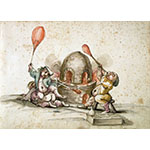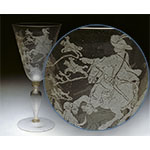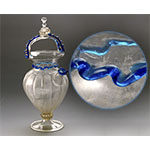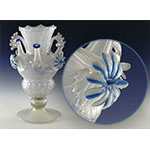The vases and glasses in the Accademia del Cimento glassware collection display highly specific patterns. These can be found in contemporary documents, and some were typical of Venetian glassmaking. The objects were produced with different techniques:
The French expression describes many blown-glass objects produced in the sixteenth and seventeenth centuries by the Murano glassmakers and by craftsmen imitating their style in Holland, Belgium, Spain, and Tuscany.
Process for hollowing, engraving, or scratching glass and crystal surfaces. Always carried out with a grinding-wheel or diamond point.
Special effect obtained by using pincers to "pinch" ornaments composed of still-plastic glass filaments. The technique served to shape handles, crested decorations, wings, cords, and other decorative elements.
Typical Tuscan process used at the Medici glassworks as early as 1591. Involved shaping glass parts under the heat of a lamp. The method served to make small objects—mainly flowers—but also birds, dolphins, and other animals. Actually, lampworking reached Tuscany even earlier. By 1587, glassmakers producing small lampwork items were accommodated in the craft workshops on the ground floor of the Uffizi.









![À la façon de Venise [Venetian style]](/images/cat/approfondimenti_150/0620_3173_3676-001_elab_150.jpg)



![Mezza stampatura [Half stamping]](/images/cat/approfondimenti_150/0620_3173_4105-019_elab_150.jpg)